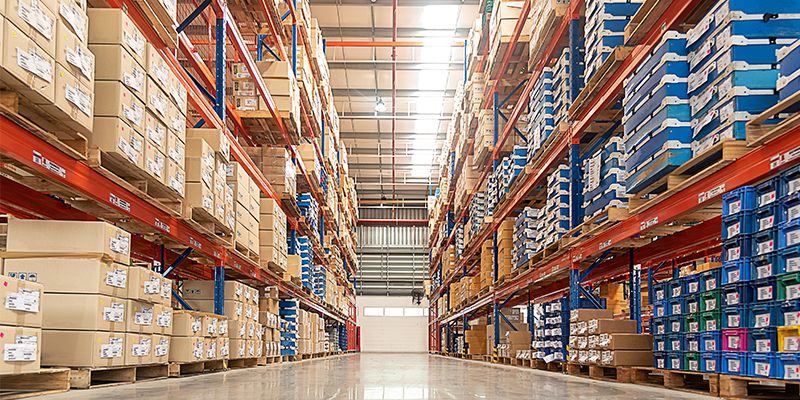After the initial shock of the pandemic, industrial real estate emerged as one of the asset classes least affected by the ensuing economic downturn. While the causes are multifaceted, the sudden spike in demand for products ordered and curbside pick-up meant that retailers – both online and brick-and-mortar – scrambled to secure the space they needed to fulfill the influx of new orders.
As the holiday season nears, a still-surging industrial market is facing a two-fold challenge: E-commerce continues to grow, and global supply chain shortages are producing bottlenecks along the logistical chain. To navigate these challenges, several huge industrial properties are being developed to assist companies with getting the logistical leeway they need. Using property data provided by CommercialEdge, real estate listing platform CommercialSearch analyzed the largest properties scheduled for completion in Q4:
8 out of 10 Largest Q4 Completions to be Occupied by Retailers
Much of the industrial market is currently focused on online retail fulfillment, which is why most of the properties scheduled to be completed this quarter are being developed for retail giants.
Amazon —the biggest online retailer and the second-biggest U.S.-based company by revenue overall — was predictably behind several large-scale industrial developments. Earlier in the year, Amazon opened three properties larger than 3 million square feet each in Philadelphia, Houston and Nashville. Now, the company is poised to deliver four out of the five largest industrial properties in Q4. The largest among these is expected to be the 3.8-million-square-foot distribution center in Austin, Texas, which is being developed on a 94-acre lot. The Austin area has seen remarkable growth in industrial development, seeing a 511% year-over-year jump in deliveries in 2021 according to a previous CommercialSearch study.
Also in Amazon’s pipeline are a 3.6-million-square-foot distribution center in Windsor, Connecitcut, one in Albuquerque, New Mexico, spanning 2.5 million square feet that the company has dubbed “Project Chico,” and another warehouse that will add 2.3 million square feet of Los Angeles industrial space. Further down the list, Amazon is also poised to open another 1.35-million-square-foot warehouse in Philadelphia, which is expected to be this quarter’s tenth-largest completion.
The e-commerce giant’s rapid expansion speaks volumes to the need for storage and fulfillment centers with the ever-growing number of orders. Following this trend, several brick-and-mortar retailers also invested in large distribution centers to better service their online customers.
More specifically, the discount department store brand Ross is developing a 2.16-million-square-foot distribution center in Brookshire, Texas. Similarly, metro Houston will be home to two new warehouses approximately spanning 1.5 million square feet each, to be occupied by Floor & Decor and Clayco, respectively. The construction company also has a warehouse in metro Birmingham, Alabama — this quarter’s fourteenth-largest completion.
Tesla’s Texas Gigafactory to be Q4 2021’s Largest Industrial Completion
Despite the dominance of retail distribution centers in the top 10, Q4’s largest industrial completion is actually scheduled to be a manufacturing facility: Tesla’s new Gigafactory (also known as Giga Texas), which will span at least 4 million square feet of Austin industrial space upon completion in December. This makes it the largest automobile factory in the U.S. by more than 1.4 million square feet and is evidence of the growing electric vehicle market. The mile-long property is scheduled to begin full-scale production in early 2022.
There was one other manufacturing facility among the 10 largest completions set for Q4: Intel’s expansion of its Ronler Acres Campus, which will add an additional 1.5 million square feet of industrial space to the chipmaker’s facilities in Portland, Oregon.
Port Markets Take the Forefront as Supply Chain Issues Grow
Another defining characteristic of the current industrial real estate market is a growing emphasis on properties in port markets. With the spike in global shipping that led to the Ports of Los Angeles and Long Beach being open 24/7 to keep up, companies need more industrial space in critical areas to account for rolling delays due to bottlenecks.
According to CommercialEdge data, prices are increasing in high-demand industrial markets such as Inland Empire, California, Los Angeles and Seattle. Vacancies in industrial real estate are also at record lows, with the national average resting at 5.9%. There are more than 500 million square feet of industrial space under construction nationwide and a further 500 million in the planning stages. Still, the 1 billion square feet in the pipeline may not cover growing demand because a considerable number of properties under development will be owner-occupied or purpose-built for a single tenant, and the high-volume coastal markets which are currently seeing the lowest vacancies have far less developable space than inland markets.
As a result, the complex situation generated by the multitude of factors affecting the industrial real estate market — starting with the pandemic and continuing with supply chain issues — is putting pressure on developers to build more space to cover the growing demand, though some dense markets may continue to see supply issues even with the increasing amounts of space being developed.
Find out more about the Q4 2021 industrial pipeline in the full CommercialSearch study.















